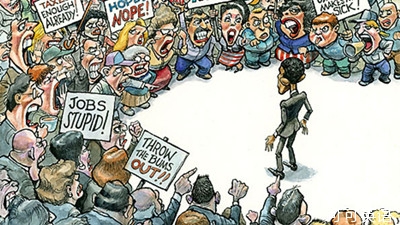商業(yè)報道
Companies and emissions
企業(yè)使命
Carbon copy
復(fù)寫本
Some firms are preparing for a carbon price thatwould make a big difference
一些公司準(zhǔn)備使用碳價 這將帶來極大的轉(zhuǎn)變
THE marketsfor CO2 have had about as good a year as Obamacare.
對二氧化碳的市場管理就如同奧巴馬醫(yī)改一樣,實施已有一年了。
Europe'semissions-trading system, the world's largest carbon market, collapsed inApril.
歐洲碳排放交易系統(tǒng)作為全球最大的碳市場在今年四月崩潰。
Australia'snew government is killing off that country's fledgling market.
澳大利亞的新任政府正在遏止該國羽翼未豐的市場。
Yet companiesare blithe.
然而公司的經(jīng)理人是很高興的。
 Internal carbon prices, the price of a tonne of CO2 used for planning purposes within firms, are becoming an increasingly common business tool.Perhaps firms know something that markets and politicians do not.
Internal carbon prices, the price of a tonne of CO2 used for planning purposes within firms, are becoming an increasingly common business tool.Perhaps firms know something that markets and politicians do not.
內(nèi)部碳價作為用于公司內(nèi)部計劃目的的每噸二氧化碳的價格,正逐步成為一個常用的商業(yè)工具。或許企業(yè)的管理者知道與此相關(guān)的事物,而這卻不在市場及政治家考慮的范圍之內(nèi)。
A study byCDP, a research group, asked large firms based or operating in America whattools they had for managing risk; 29 said they used an internal carbon price.
一個名為CDP的研究機(jī)構(gòu)做了一項調(diào)查。該調(diào)查詢問美國的公司或在美國經(jīng)營的公司采用何種方式進(jìn)行風(fēng)險管理。29家公司表示他們用內(nèi)部碳價進(jìn)行風(fēng)險管理。
Anecdotally, more apply such a price but did not mention it as a risk-mitigation measure.
更為讓人驚奇的是,更多的公司運(yùn)用這種策略卻不稱之為風(fēng)險緩和措施。
This is the first economy-wide picture of how farinternal carbon pricing has gone and what it is used for.
這是第一幅展現(xiàn)內(nèi)部碳價的作用的經(jīng)濟(jì)全景圖。
The pricesrange from 6-7 a tonne of carbon dioxide at Microsoft to 60 a tonne at ExxonMobil.
每噸二氧化碳的定價根據(jù)公司不同而不同,從微軟每噸6-7美元到埃克森美孚每噸60美元。
The span is not surprising, since companies use carbon prices for different purposes.
因為各個公司出于不同的目的制定碳價,這種差別并非驚人。
As a rule, those whose assets have a long productive lifeand which might be affected by green policies far into the future use higher prices than consumer-goods firms whose products aremainly influenced by current policies.
通常,那些生產(chǎn)較長壽命的設(shè)備的公司及在未來受環(huán)保政策影響的公司的碳價比那些主要受當(dāng)前政策影響的消費(fèi)品公司的高。
For manycompanies the aim is to prepare themselves for future environmentallegislation.
對許多公司來說,他們制定碳價的目的是為將來的應(yīng)對環(huán)保立法做準(zhǔn)備。
AEP, a power supplier, says it uses the system because it assumesa price of carbon…will begin in the US by roughly 2020.
美國電力公司這個電力供應(yīng)商稱他們利用該定價系統(tǒng)因為該公司人碳價…大約會在2020年在整個美國普及。
Delta AirLines says it uses a price for evaluating flights to Europein anticipation of compliance with EU ETS.
德爾塔航空公司稱該公司利用定價機(jī)制評估飛往歐洲的航班,以期歐洲電信標(biāo)準(zhǔn)作出讓步。
This is notthe only reason.
這并非唯一的原因。
Many firms use an internal carbon price to calculate the valueof future projects and to guide investment decisions.
許多公司利用內(nèi)部碳價計算未來項目的價值從而指導(dǎo)投資決策。
Conoco Phillips, an oilfirm, requires that capital projects worth over 75m calculate the cost ofemissions based on a price of between 8 and 46 a tonne, depending on the lifeof the project.
康菲石油公司要求超過7500萬美元的重要項目,必須根據(jù)項目的生命周期以每噸8-46美元的價格計算二氧化碳排放的成本。
The forecast value of a new oilfield would be: estimated outputmultiplied by the estimated future oil price minus development costs and carbonemissions.
估計一個新油田的價值將會是:預(yù)計產(chǎn)量+預(yù)估未來的油價-開發(fā)成本-碳排放成本。
Shell,another oil company, applies a carbon price—40 a tonne—to some currentoperations, not only future ones.
另一個石油公司英荷殼牌不僅僅對未來的項目,即便是當(dāng)下運(yùn)作的項目,也采取每噸40美元的碳價。
The idea is to identify tall poppies.
這一思想旨在確認(rèn)最高碳價。
The price implies that existing projectscould spend up to 40 to reduce a tonne of CO2.
該定價暗示現(xiàn)有項目每減少一噸二氧化碳的排放需花費(fèi)40美元。
Angus Gillespie, Shell's vice-president for CO2, says we applythe carbon price as much to spur mitigation as to quantify risks.
英荷殼牌負(fù)責(zé)二氧化碳事宜的副總裁安格斯?吉萊斯皮稱我們運(yùn)用碳價來盡可能地緩解量化危機(jī)。
Disney, amedia conglomerate, goes further still.
媒體企業(yè)集團(tuán)迪斯尼公司走得更深更遠(yuǎn)。
It invests in schemes to offset orreduce carbon emissions and charges the cost of these to business units in proportionto how much they contribute to the company's overall emissions.
該公司投資商業(yè)計劃來抵消或減少碳排放并將碳排放的成本按照它們占公司總排放量的比例納入商業(yè)單位。
In effect, thisworks like an internal carbon tax.
實際上,這就相當(dāng)于一種內(nèi)部碳稅。
Perhaps themost intriguing thing about the prices, though, is how high some of them are.
可能碳價最吸引人的地方就是它們能達(dá)到多高。
The market price of carbon is 4.90 per tonne of CO2 in the EU, 11.50in California.
每噸二氧化碳排放的市場價在歐洲是4.9歐元,加利福尼亞是11.5美元。
Big oil companies charge 34 or more. That is closer to the social cost ofcarbon—the damage from an extra tonne of CO2—than to the market price.
大型石油公司定價為34美元或更多。這比市場碳價更接近社會碳成本—一噸碳導(dǎo)致的破壞。
America'sadministration recently estimated the social cost at 37 a tonne.
美國行政機(jī)構(gòu)近期估計社會碳成本是每噸37美元。
These priceschange behaviour.
這些定價改變?nèi)藗兊男袨椤?/div>
A huge amount of attention is paid to government action.
人們更加重視政府的行動。
But the sort of carbon price some companies are using for planning would, if itbecame a market price, have a much bigger impact than any of the policies thatgovernments are now talking about.
但是某些公司運(yùn)用這種碳價來制定商業(yè)計劃,倘若該價格成為市場價格,將會比政府現(xiàn)在討論的任何政策產(chǎn)生更大的影響。
 Internal carbon prices, the price of a tonne of CO2 used for planning purposes within firms, are becoming an increasingly common business tool.Perhaps firms know something that markets and politicians do not.
Internal carbon prices, the price of a tonne of CO2 used for planning purposes within firms, are becoming an increasingly common business tool.Perhaps firms know something that markets and politicians do not.
 Internal carbon prices, the price of a tonne of CO2 used for planning purposes within firms, are becoming an increasingly common business tool.Perhaps firms know something that markets and politicians do not.
Internal carbon prices, the price of a tonne of CO2 used for planning purposes within firms, are becoming an increasingly common business tool.Perhaps firms know something that markets and politicians do not.